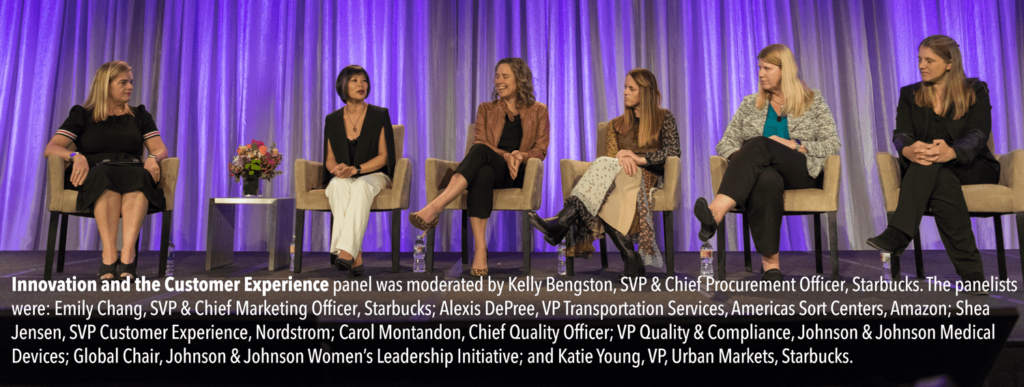
At the 2019 AWESOME Symposium, one panel featured a retail organization that sells high-end fashion, a health care and medical device company that touches people at every stage of life, a company that built their brand on being a warm and inviting environment, and a company that epitomizes the trend toward digital commerce. Did they have views on how customer experience and the supply chain are closely connected? Absolutely!
Each has faced challenges when it comes to giving customers what they want.
Nordstrom, represented on the Symposium panel by Shea Jensen, SVP, Customer Experience, has always prided itself on giving personal attention inside the store. Now they’re taking into consideration that what many of their customers want is speed and convenience when they shop.
Johnson & Johnson, represented by Carol Montandon, Chief Quality Officer; Vice President Quality and Compliance, Medical Devices , faces the reality every day that if any one of the multiple products they provide for one critical surgery fails to arrive, someone’s life could be affected.
Starbucks, represented by Emily Chang, SVP and Chief Marketing Officer, and Katie Young, VP, Urban Markets, became a huge success on being a “third place” where people could feel comfortable between home and work – and now they’re pleasing customers with other options, such as drive-through and mobile orders.
And Amazon — represented by Alexis DePree, VP, Transportation Services, Americas Sort Centers – the company that gave everyone a lesson in succeeding without bricks and mortar, is now opening actual bookstores and markets, while still exploring innovative concepts in ways of transacting business.
 As moderator Kelly Bengston, SVP and Chief Procurement Officer, Starbucks, probed for insights into customer experience and innovation, there are things about which the panelists agreed:
As moderator Kelly Bengston, SVP and Chief Procurement Officer, Starbucks, probed for insights into customer experience and innovation, there are things about which the panelists agreed:
- Pleasing the customer sometimes requires knowing what they want before they do.
Spending time in the customer’s “shoes” regularly can provide the most valuable lessons.
Staying close to employees/associates/partners and learning what they observe is also necessary. (And the experience of those who work for the company will end up affecting customer experience, too.)
It pays to encourage employees to give feedback; one company does this with a marker board where employees can write what’s on their mind.
Interesting insights about customer experience come from social media.
To stay on track, it helps to work from the store back, from the customer back, from the employee back.
When big changes happen, it’s important to help employees anticipate and understand the change thoroughly.
Innovation is essential to providing the best customer experience because the customers’ needs are always changing.
How do they stay close to the customer?
 Emily Chang talked about visiting a Starbucks location one Sunday and striking up a conversation with a man she’d noticed there before. It turns out, he comes to that location every day and travels a distance to get there. He said, “This is my chair. This is my place.”
Emily Chang talked about visiting a Starbucks location one Sunday and striking up a conversation with a man she’d noticed there before. It turns out, he comes to that location every day and travels a distance to get there. He said, “This is my chair. This is my place.”
 Carol Montandon spoke of the way she and her team members actually observe surgeries to see how their implements are used; to notice if there would be any way to make the process more efficient. J&J also uses data analytics to provide insights to doctors that help them choose which products to use for which patients.
Carol Montandon spoke of the way she and her team members actually observe surgeries to see how their implements are used; to notice if there would be any way to make the process more efficient. J&J also uses data analytics to provide insights to doctors that help them choose which products to use for which patients.
 Shea Jensen talked about one initiative in which Nordstrom took a subset of 800 customers and spent nine months doing focus groups, events, and product design. What resulted was more than 400,000 points of data.
Shea Jensen talked about one initiative in which Nordstrom took a subset of 800 customers and spent nine months doing focus groups, events, and product design. What resulted was more than 400,000 points of data.
 Katie Young explained that Starbucks has a way of “trying out” design ideas before they become permanent. There’s a space where prototypes can be built to get customer and partner feedback quickly.
Katie Young explained that Starbucks has a way of “trying out” design ideas before they become permanent. There’s a space where prototypes can be built to get customer and partner feedback quickly.
 Alexis DePree described how Amazon likes to use a system of asking multiple teams to write a “PR FAQ” – (modeled after a public relations information sheet of “frequently asked questions”) about a new idea or a problem. Amazon, she said, believes in the Darwinian theory that the best will eventually rise to the top. Alexis’ comment: Holy chaos!
Alexis DePree described how Amazon likes to use a system of asking multiple teams to write a “PR FAQ” – (modeled after a public relations information sheet of “frequently asked questions”) about a new idea or a problem. Amazon, she said, believes in the Darwinian theory that the best will eventually rise to the top. Alexis’ comment: Holy chaos!
More words of wisdom from the Customer Experience and Innovation panel:
- “The world is changing. The role of the store is changing. We know that a large majority of customers have started their journey somewhere else.”
“Supply chain plays a critical role in customer journeys…for example, buy online and pick up in the store. How do you make it super easy for our customer to come in and find the merchandise they’ve already paid for and make sure the employee that hands the package to that customer has a smile on their face?”
“The best way to serve customers in the spirit of innovation is to have them help guide you where to go.”
“We are big believers that the innovation should come from lots of pockets.”
“Innovation is everyone’s role.”
“Innovation is creating something that doesn’t exist – and should.”
“If you want innovation, you have to have diversity of perspectives. And if you want diversity of perspectives, you have to invite it in.”
“As we build teams for the future, I want supply chain’s input. I want them building strategy with me. I want them there from day one, thinking about how we do store design, how we design products.”
“You don’t know how far you can reach until you stretch for that trapeze.”
“I’m not a leader because I know my subject matter better than anyone else. I’m a leader who has the agility to learn something new, to define something differently and to take my team there.”